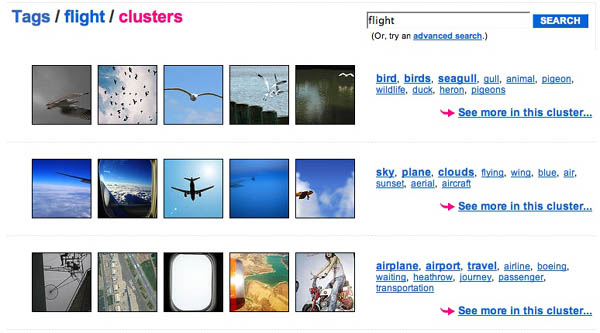Clusters
Flickr has unveiled a pair of new tools for sifting through its 31 million images. The first is tag clustering, which breaks up single-term tag searches into clusters based upon patterns among coinciding tags. For instance, a search for “flight” yielded three clusters (see screenshot below): one with a preponderance of birds, one with shots of airplanes, and a third with general scenes of air travel. A search for Europe might yield separate clusters for France, Italy, and Germany, and might also set apart images with a high incidence of cathedrals.

Tagging has always been central to the Flickr experience, but given the incredible volume of images, it goes only so far in helping one dig out items of interest. There is always the option of an advanced search, which narrows down a query to images that have two or more tags in common. But tagging is an idiosyncratic business and the more refined the search, the more brilliant your guesswork must be.
Clusters aren’t a bad alternative. They find a middle ground between the single tag avalanche and the razor-sharp advance search, turning up groups with nice, fuzzy affinities. From now on, I might check clusters before moving on to an advanced search.
Interestingness
One unfortunate fact in Flickr (and the web in general) is the brutal hierarchy of time. The more recent a thing is, the easier it is to find. More a pile-up than an archive, it’s difficult to get to anything that’s not in the vicinity of the upper layers. Recognizing this, Flickr has initiated a Google-style ranking system called “interestingness.”
Carrying on the Flickr tradition of cute, exuberant terminology, “interestingness” is based on an algorithm that ranks images on a kind of impact index, judging by number of times viewed, number of times marked as “favorite,” number of comments, diversity of click-throughs, etc. For any given day of any given month, you can see what the algorithm has determined to be the 500 most interesting images. You can also sort tag search results by “most interesting,” and can even see what the algorithm thought of your own personal photostream.
When it came to my own images, I found the machine to be a poor curator, since what I consider to be my most interesting images have, for whatever reason, been viewed less frequently. A popularity contest does not always award the most deserving. But looking at the monthly exhibits, its hard to deny the quality of the selection. I highly recommend visiting the “explore” page.
if:book
A Project of the Institute for the Future of the Book
